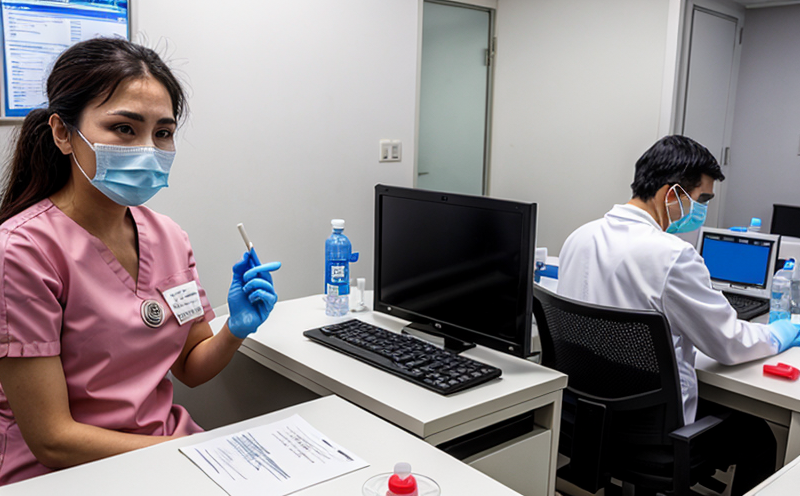Rotavirus Detection Testing in Veterinary Animal Models
The detection of rotavirus infections in veterinary animal models is critical for understanding and controlling gastrointestinal diseases that affect young animals. Rotaviruses are a group of viruses belonging to the family Rotaviridae, which can cause severe diarrhea, dehydration, and even death in neonatal animals such as calves, piglets, and kittens.
Rotavirus infection is a significant concern for the veterinary community due to its high prevalence and rapid transmission. The ability to accurately detect rotavirus in animal models helps researchers identify potential vaccine candidates, evaluate treatment efficacy, and study disease progression under controlled conditions. This service offers comprehensive testing protocols that ensure reliable identification of rotaviruses using advanced diagnostic techniques.
The first step in detecting rotavirus involves sample collection from the animal model, which typically includes fecal samples or tissue biopsies. Specimen preparation is crucial for accurate results; it may involve homogenization followed by centrifugation to concentrate viral particles. Once prepared, these samples are tested using a combination of methods including ELISA (Enzyme-Linked Immunosorbent Assay), PCR (Polymerase Chain Reaction), and immunofluorescence assays.
ELISA tests provide rapid results but have limited sensitivity compared to other methods. PCR-based approaches offer higher specificity and sensitivity, making them ideal for confirming positive ELISA outcomes or detecting low viral loads. Immunofluorescent staining allows visualization of virus particles directly within tissues, providing valuable morphological data that can aid in diagnosis.
Quality control measures are essential throughout this process to maintain accuracy and consistency. Standards such as ISO 15189 and CLSI guidelines ensure laboratories adhere to best practices when handling samples and interpreting results. Regular calibration of equipment against known standards further enhances reliability.
- Sample Collection: Fresh fecal samples or tissue biopsies from affected animals.
- Preparation: Homogenization followed by centrifugation to concentrate viral particles.
- Detection Methods: ELISA, PCR, Immunofluorescence Assays.
- Quality Control: Adherence to ISO 15189 and CLSI guidelines; regular calibration against known standards.
The importance of accurate rotavirus detection cannot be overstated. By providing precise diagnostic information, this service supports research efforts aimed at developing effective therapies for neonatal animals affected by rotaviral enteritis. Our team uses state-of-the-art technology and adheres strictly to international standards to deliver reliable test results.
Why It Matters
The detection of rotavirus infections in veterinary animal models is crucial for several reasons:
- Prevention: Early identification allows timely intervention, reducing the spread of infection within facilities.
- Vaccine Development: Accurate testing helps researchers identify potential vaccine targets and assess immunogenicity.
- Treatment Efficacy: Monitoring viral load changes over time aids in evaluating therapeutic strategies.
- Epidemiology: Understanding patterns of transmission contributes to better infection control measures.
In summary, reliable rotavirus detection supports both research and clinical objectives, ultimately leading to improved animal health outcomes.
Quality and Reliability Assurance
To ensure the highest level of accuracy in our tests, we implement rigorous quality assurance protocols. These include:
- Standard Operating Procedures (SOPs): Detailed guidelines for every step of the testing process.
- Calibration: Regular calibration against known standards to maintain equipment precision.
- Routine Audits: Periodic reviews conducted by senior staff members to identify potential errors or improvements.
- Positive and Negative Controls: Use of these controls ensures that tests are both sensitive and specific.
In addition, our laboratory personnel undergo continuous training on the latest diagnostic techniques and methodologies. This commitment to excellence guarantees consistent high-quality results every time.
Use Cases and Application Examples
Rotavirus detection testing in veterinary animal models finds application across various scenarios:
- Vaccine Testing: Evaluating the effectiveness of new rotavirus vaccines through controlled trials.
- Treatment Monitoring: Assessing how different treatments impact viral load and symptom severity.
- Epidemiological Studies: Investigating patterns of rotavirus infection within specific populations or environments.
- New Drug Development: Screening compounds for their anti-viral properties in preclinical studies.
These applications demonstrate the versatility and importance of accurate rotavirus detection in veterinary research. By providing precise data, our service plays a vital role in advancing knowledge about this important pathogen.





